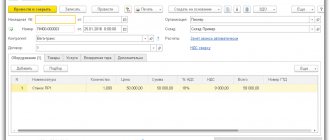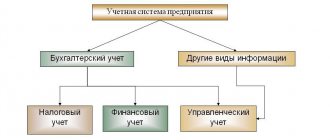The organization maintains tax records, calculates income tax, pays it and reflects it in the tax return in accordance with the norms of tax legislation. From an accounting point of view, the calculated amount of income tax is a fait accompli of economic life. About how calculated income tax is taken into account in accounting, how the application of the provisions of PBU 18/02 affects accounting entries when calculating tax, and how analytical accounting of calculations with the budget for income tax is organized in “1C: Accounting 8” edition 3.0 , say 1C experts.
Income tax - which account to use for accounting
To account for this tax, use a subaccount to account 68. In the 1C accounting program, it is assigned the number 68.04, and two subaccounts, in turn, are linked to it: 68.04.1 “Calculations with the budget” and 68.04.2 “Calculation of income tax.”
If you do not apply PBU 18/02, then the question of which income tax account to use is easily resolved: the tax is calculated by posting Dt 99 Kt 68.04.1, and is immediately attributed to the subaccount for accounting settlements with the budget.
If the company applies PBU 18/02, then the amount of income tax is calculated in accounting through a system of accounting entries with the participation of subaccount 68.04.2. As a result, in subaccount 68.04.2, when calculating tax payable, the amount recorded in the declaration should be formed. Then the total amount of subaccount 68.04.2 is completely closed to subaccount 68.04.1, where the tax is divided among budgets. It also takes into account further settlements with the budget based on the amount accrued for payment.
Which accounting accounts are involved in the postings?
All operations for calculating taxes are displayed on the credit of account 68. To display the accrual of income tax, a special sub-account is opened for it.
When calculating profit taking into account the norms of PBU 18/02 (approved by order of the Ministry of Finance dated November 19, 2002 No. 114n), reduction to the general value of the desired value calculated in tax and accounting is observed. In order to link the differences that arise (temporary and permanent) when calculating income tax, various accounting entries are used. The appearance of these differences is due to the fact that not all expenses in tax accounting reduce taxable profit, but at the same time they are taken into account in accounting. It is for the purpose of subsequent correction of the profit calculated in accounting that it is necessary to take into account all the differences that arise.
Read more about the differences between accounting and tax accounting here.
Depending on what difference the taxpayer received during the reporting period (deductible or taxable), different entries are applied.
Accounting for income tax according to PBU 18/02
The use of PBU 18/02 allows you to trace the entire tax formation scheme, taking into account the difference between accounting and tax accounting, which can be permanent or temporary.
Permanent differences are formed by income and expenses that are not taken into account for tax purposes. Temporary differences arise when there is a discrepancy in the timing of the acceptance of income and expenses in accounting and for tax purposes. The overwhelming majority of the temporary difference consists of expenses that are taken into account differently for accounting and tax purposes. A significant part of expenses in accounting is accepted earlier than in tax accounting. But the opposite situations also occur.
Postings for calculating personal income tax
Organizations and individual entrepreneurs pay income tax as a tax agent for their employees. It must be transferred on the day of payment of wages and other income of the employee.
To calculate taxes Residents and non-residents have their own tax rates. Also, the percentage of collection in favor of the state depends on the type of income and category of the employee.
Example:
At the end of June, income tax was calculated on the accrued wages of employees in the amount of 68,927 rubles. In addition, dividends were paid to the founders. The tax on them amounted to 74,231 rubles.
Postings:
| Account Dt | Kt account | Wiring Description | Transaction amount | A document base |
| 68 "NDFL" | Posting for calculating personal income tax on salary | 68 927 | Payslip | |
| 72.2 | 68 "NDFL" | Personal income tax accrued on dividends | 74 231 | Tax card for personal income tax, accounting certificate |
| 68 "NDFL" | Posting the transfer of personal income tax on salary | 68 927 | Ref. Payment order | |
| 68 "NDFL" | Personal income tax on dividends transferred | 74 231 | Ref. Payment order |
Postings to the debit of account 68 when generating income tax
You can understand which income tax account should be used when applying PBU 18/02 using the following algorithm. The tax in this case is formed as follows:
- The tax calculated from accounting profit is documented by posting Dt 99 Kt 68.04.2.
- Tax amounts (permanent tax liabilities) accrued from the permanent difference are taken into account:
- Dt 68.04.2 Kt 99 – from income not taken into account for tax purposes;
- Dt 99 Kt 68.04.2 – from expenses not taken into account for tax purposes.
3. Tax amounts accrued from temporary differences at the time of their occurrence in accounting are taken into account:
- Dt 09 Kt 68.04.2 – deferred tax assets (for expenses accepted in accounting earlier than in tax accounting);
- Dt 68.04.2 Kt 77 – deferred tax liabilities (for expenses accepted in tax accounting earlier than in accounting).
4.Tax amounts are taken into account for previously accrued temporary openings for which it became possible to close in a given period. Which account - deferred tax assets or deferred tax liabilities - is closed depends on the type of temporary difference:
- Dt 68.04.2 Kt 09 – deferred tax assets (for expenses accepted in accounting earlier than in tax accounting);
- Dt 77 Kt 68.04.2 – deferred tax liabilities (for expenses accepted in tax accounting earlier than in accounting).
Results
The application of PBU 18/02 often raises questions. But once you clearly understand the concepts of ONO, ONA, PNR and PND discussed above, you can easily cope with bringing the balance in account 68 to the amount of income tax shown in the declaration.
See also: “What is the procedure and deadlines for paying income tax (postings)?”
You can find more complete information on the topic in ConsultantPlus. Free trial access to the system for 2 days.
Accounting for income tax in accounting
Accounting displays profit or loss at the end of the reporting period; this result is used to calculate the payment of current income tax to the budget . The accounting account for recording calculations is given below.
The amount of profit or loss resulting from the activity (line 2300 of the income statement) is multiplied by the current tax rate - 20%, which leads to the creation of amounts of conditional income or conditional expense. But this is not the final figure for transferring tax; it is adjusted for differences. In their absence, the amount received will be equal to the tax payable.
If the company has an unimportant result of its activities, that is, a loss, then a conditional income is formed by multiplying the amount of the loss by a rate of 20%. The entries that display it are as follows:
Kt 99, with the opening of a separate sub-account “Conditional expense (income) for income tax” - Dt 68 (calculation of income tax).
The resulting accounting profit, multiplied by 20%, is a conditional income tax expense. It must be written down with the following entries: Dt 68 – Kt 99.2.
VAT payment
VAT is calculated based on the results of the quarter. The amount payable is divided into equal shares over three months and paid after the end of the reporting period. You can pay the entire tax at once or an amount exceeding 1/3.
VAT payable is charged on sales for core activities, non-operating income and upon restoration.
Example:
Victoria LLC accrued VAT on its core activities at the end of the second quarter in the amount of 87,589 rubles, the VAT accepted for deduction as an advance in the last quarter in the amount of 48,598 rubles was restored, and VAT on the sale of fixed assets was 8,958 rubles.
Postings for VAT transfer:
| Account Dt | Kt account | Wiring Description | Transaction amount | A document base |
| 90.3 | 68 "VAT" | VAT charged on sales | 87 589 | Accounting information |
| 76AB | 68 "VAT" | VAT restored | 48 598 | Sales book |
| 91.2 | 68 "VAT" | VAT accrued on the sale of fixed assets | 8958 | Certificate of acceptance and transfer |
| 68 "VAT" | Posting of tax transfer to the budget | 145 145 | Ref. Payment order |
Accounting for income tax in tax accounting
They are deducted from the income received by the organization, but not all expenses can be recorded in tax accounting.
According to the general rule established by Art. 252 of the Tax Code, the company’s expenses in tax accounting must be:
a) justified, that is, economically necessary for the company, for example, the purchase of coffee for accounting employees cannot be written off as an expense, they cannot be called justified;
b) confirmed by documents drawn up correctly, in accordance with legal requirements. These can be any supporting documents: travel cards, orders, reports on work performed, etc. If documents are submitted from a foreign state, they must be translated into Russian. But you must take into account that you must have a complete set - if this is a contract, then it must include a certificate of completion of work, an invoice, shipping documents, etc. When only an invoice is attached to the contract, such expenses cannot be recognized. The Federal Tax Service also recommends using a universal transfer document to confirm expenses.
c) expenses must be made to generate income, which is generally the main thing for the commercial activities of any company. If there is no income in a given month, then the expense can still be recognized, the main thing is that the expenses were incurred for their type of activity.
If an expense does not meet at least one of the above requirements, it cannot be accepted, so some of the expenses are not recognized in tax accounting at all.
Tax authorities also pay attention to expenses that brought a loss in the reporting period, did not bring profit, and do not correspond to the main type of activity. Expenses that are taken into account within established standards are called standardized . There are also non-standardized ones, they are taken into account completely.
Expenses from core activities include those associated with production and sales, namely: costs of performing work, providing services, manufacturing, storing and delivering goods, maintaining fixed assets, insurance, etc.
Closing account 99 at the end of the year
At the end of the year, the balance sheet is reformed - all subaccounts to accounts 90, 91 and 99 are closed with internal entries. After this, the balance remains only on subaccount 99.01. This is the financial result of the reporting year; it is written off to account 84.
Reformation of the balance sheet is the final operation of the reporting year. As of January 1 of the following year, the balance in account 99 should be zero.
If at the end of the reporting year a profit is made (the account balance is 99 credits), the following entry is made:
Debit 99 Credit 84 - reflects the net profit of the reporting year.
If at the end of the reporting year a loss is received (account balance 99 is debit), the following entry is made:
Debit 84 Credit 99 - reflects the net (uncovered) loss of the reporting year.
How to reflect profit or loss from sales in accounting
Transactions for ordinary activities are recorded on the account. 90 "Sales". Here, revenue, cost, VAT, and excise tax indicators are collected in separate subaccounts. The financial result from this activity will be obtained arithmetically, and the accounting entries will look like this:
- Dt 90.9 Kt 99 - for fixing profits;
- Dt 99 Kt 90.9 - to record losses.
To learn how the cost price is collected, read the publication “What costs does the commercial cost of production include?”
The practical guide to preparing financial statements from ConsultantPlus shows in detail the procedure for reflecting retained earnings in the balance sheet.
What profits are taxable?
- Russian enterprises take as profit the difference that remains from income after deducting all production expenses. Which specific cost items are usually called production costs are indicated in the Tax Code.
- Foreign firms and companies that operate through representative offices and have sources of income within Russia consider their profit to be the difference between all income received and the costs incurred by these representative offices.
- For all other foreign organizations - income that was received from sources in the Russian Federation.
Differences between NU and BU data
Every time any income or expense is reflected differently in tax and accounting, a so-called difference arises. There are two types of differences: temporary and permanent. It is extremely important for an accountant to determine which type a particular amount belongs to.
Temporary differences
Temporary differences are income and expenses that are reflected in accounting records in one reporting period, and in accounting records in another period. A distinctive feature of the temporary difference is that sooner or later there will come a time when the discrepancy between tax and accounting accounting will be reduced to zero.
Example 1
The company commissioned a fixed asset facility. Its initial cost is 120,000 rubles, its useful life is five years.
The accounting policy stipulates that for accounting purposes the linear depreciation method is used, and for accounting purposes the method of writing off value in proportion to the volume of production is used. Because of this, the amount of monthly depreciation deductions according to tax accounting data will differ from the amount of deductions according to accounting data. As a result, there is a difference every month.
At the end of the useful life, the original cost will be completely written off both in accounting and tax accounting. In this case, the total amount of depreciation accrued over five years, both in NU and BU, will be 120,000 rubles. This means that the discrepancy between tax and accounting will be reduced to zero. Based on this, the accountant concluded that the difference arising from the discrepancy in the monthly depreciation amount was temporary.
Example 2
The organization reflects vacation pay in accounting and tax accounting differently.
In accounting, the company creates a reserve for upcoming vacation expenses. To do this, a certain amount is written off monthly to the debit of the “cost” account and the credit of account 96 “Reserves for future expenses.”
In NU, vacation pay is written off as an expense for the month in which the vacation falls.
Thus, a difference arises monthly in the form of amounts written off as expenses in accounting.
After an employee uses vacation, tax accounting will generate costs for the full amount of vacation pay. In this case, the total amount of vacation pay according to the NU data will coincide with the amount that during the previous months was included in the reserve according to the accounting data. This means that the discrepancy between tax and accounting will be reduced to zero.
Based on this, the accountant concluded that the difference arising from the monthly recording of costs in accounting is temporary.
We add that temporary differences must be taken into account for each type of asset and liability. This means that it is necessary to organize analytical accounting of temporary differences in the context of fixed assets, reserves, etc.
Constant differences
Permanent differences are income and expenses that are reflected in only one accounting: either tax or accounting. A distinctive feature of a permanent difference is that the discrepancy between NU and BU will never be canceled.
Example 3
The company spent 200,000 rubles on advertising. In accounting, these costs are written off in full. For tax purposes, expenses were written off within 1% of sales revenue, which amounted to RUB 50,000. As a result, there was a difference equal to 150,000 rubles (200,00 rubles - 50,000 rubles).
Neither in the current nor in subsequent periods, part of the advertising costs in the amount of 150,000 rubles. will not be recognized by NU. Based on this, the accountant concluded that the difference is permanent.
What expenses have the right to reduce profit margin?
Production costs are precisely the part that reduces the amount of income and, as a consequence, the amount of profit and the amount of profit tax. Expenses, like income, are also divided into 2 groups:
Expenses involved in the sale or production of goods and work
These are costs that were necessary for full-fledged production or provision of services. They have documentary evidence and came from a taxpayer-legal entity. All such expenses must be expressed in monetary terms and regulated by current legislation on the territory of the Russian Federation or within the framework of a concluded agreement. These expenses include all expenses that were incurred solely to generate income. What might the production costs be?
- costs of purchasing raw materials and materials;
- payroll expenses;
- the amount of accrued depreciation charges;
- other costs.
Non-operating expenses
- penalties, penalties, fines that were paid in favor of other enterprises;
- losses of past years identified only in the reporting period;
- losses resulting from the maintenance of temporarily mothballed factories;
- changes in exchange rates in a negative direction when conducting transactions in foreign currencies.
- losses resulting from the write-off of debtors due to the statute of limitations or as a result of the insolvency of a partner;
- loss resulting from the discovery of shortages or damage to products during an inventory;
- loss resulting from the write-off of incompletely depreciated assets.
Retained earnings and its use in accounting
Retained earnings (uncovered loss) are reflected in the account of the same name. 84. Its debit balance indicates accumulated loss, and its credit balance indicates profit. By decision of the owners of the enterprise, expenses can be made at the expense of the organization’s profits or losses can be repaid from any sources.
The practical guide to preparing financial statements from ConsultantPlus shows in detail the procedure for reflecting retained earnings in the balance sheet. If you do not have access to the K+ system, get a trial online access for free.
Retained earnings can be used for the following expenses:
- payment of dividends - Dt 84 Kt 75 (or Dt 84 Kt 70, if one of the dividend recipients is an employee of the enterprise);
- formation of reserve capital - Dt 84 Kt 82;
- increase in authorized capital - Dt 84 Kt 80.
The loss, by decision of the owners, can be repaid:
- from profit - Dt 84 Kt 84 using the corresponding subaccounts;
- founders' funds - Dt 75 Kt 84;
- reserve capital - Dt 82 Kt 84;
- authorized capital (but with the condition that its amount does not become less than the amount of net assets) - Dt 80 Kt 84;
- additional capital, if there are no other sources - Dt 83 Kt 84.
Account 68 in accounting
68 accounting account is intended to carry out the procedure for summarizing information on complete calculations of fees and taxes. This takes into account not only payments sent to the budget, but also taxes paid by the company’s employees.
Drawing up reports
To make a correct account analysis, you need to take into account all types of interest rates by type of taxation. Its peculiarity is that it is both passive and active at the same time. This is influenced by the data that should be displayed on it.
Important! Filling out account documentation has its own characteristics. In addition, there are special formulas for calculating personal income tax.
Calculation of taxes and fees
Characteristics
Accounting account 68 is an active-passive instrument in accounting. It represents generalized information on calculations, including taxes that the organization pays to the budget and for employees.
All individual entrepreneurs and organizations are required to make transfers to the budget upon conducting economic activities. For legal entities in accounting, account 68 should be used for this. All transactions for paying obligations to the budget will be taken into account and formed on it. The information contains complete information about all accrued and paid tax liabilities, reflects the amounts withheld from employees, as well as those that were declared for deduction.
The question often arises: is the 68 account active or passive? It belongs to the active-passive group. This is because it has a debit and a credit balance. It depends on the nature of the debt. If there is an overpayment of taxes, the balance is considered a debit. In the case of debt, everything is calculated the other way around. The amount that must be transferred to the budget will be placed on credit balances.
Analytical accounting for the calculation of taxes and fees 68 is carried out by type of tax. The amount received is added.
Important! In one case, the balance may be a debit, in the second - a credit.
Procedure for deductions to the budget






